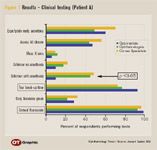Article
Practitioners see eye-to-eye when diagnosing, treating dry eye
Optometrists, general ophthalmologists, and cornea subspecialists have similar approaches to diagnosing and treating dry eye. Three clinician groups that relied on fluorescein staining and TFBUT for diagnosis found that cyclosporine emulsion 0.05% (Restasis, Allergan) was an important component of treatment for the majority of their eye-care practitioners.

Key Points

The three clinician groups surveyed reported that they relied on fluorescein staining and tear film break-up time (TFBUT) for diagnosis; ordering laboratory tests was relatively uncommon. Cyclosporine emulsion 0.05% (Restasis, Allergan) was an important component of treatment for the majority of eye care practitioners, with 60% to 70% of responding clinicians prescribing cyclosporine for patients with mild dry eye and 90% to 98% ordering cyclosporine for those with severe disease. Joseph Tauber, MD, and Scott Fudemberg, MD, conveyed the survey findings here at the annual meeting of the Association for Research in Vision and Ophthalmology.


Diagnostic measures
Considering the diagnostic measures used with patient A, corneal fluorescein staining was the most common choice among all responding clinician groups (about 90%) followed by measurement of TFBUT. About 60% of clinicians said they then would examine the eyelids for the degree of inflammation (meibomianitis or blepharitis) and eyelid closure. Schirmer's testing, the standard test for assessing dry eye disorders, would be performed less frequently than the other diagnostic tests.





